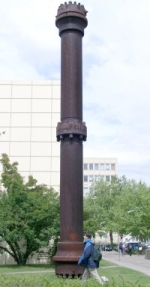History
- The institute was founded on 9. October 1900 when Max Le Blanc was appointed to the chair of "physical and electrochemistry", the first chair in electrochemistry in Germany.
- He was followed by Fritz Haber (1906), Georg Bredig (1911), Ludwig Ebert (1934) and Hermann Ulich (1940). In this period research in the fields of electrochemistry, thermodynamics and kinetics was focused on such topics as metal electrolysis, development of the hydrogene electrode, combustion studies, high pressure-high temperature chemistry and catalysis (ammonia synthesis), as well as metal colloid supported catalysis.
- After the second world war Paul Günther (1946) and Hellmuth Fischer (1958) continued this tradition including new developments in e.g. research on electrocrystallization or microwave spectroscopy.
- Following the change into a new building in 1967 the number of chairs has been increased to four, including one in theoretical chemistry. The research activities in the new laboratories have focused on: high temperature-high pressure studies of fluids (Ernst Ulrich Franck, 1961), structural and dynamical investigations of liquids, in particular, by NMR - spectroscopy (Gerhard Hertz, 1964), solvated electrons and isotope separation (Ulrich Schindewolf, 1970), interfacial electrochemistry (Wolfgang Lorenz, 1974) and abinitio quantum chemical theory (Reinhart Ahlrichs,1975).


